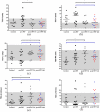Coagulation parameters in hyperthyroid cats before and after radioiodine treatment compared with healthy controls
- PMID: 30571457
- PMCID: PMC10814272
- DOI: 10.1177/1098612X18820145
Coagulation parameters in hyperthyroid cats before and after radioiodine treatment compared with healthy controls
Abstract
Objectives: The aim of the study was to describe the coagulatory state of hyperthyroid cats before and after successful radioiodine therapy (RIT) compared with healthy age-matched controls, using classical coagulation parameters and thromboelastogram (TEG) as a global assessment method. The differences in coagulation activity after RIT, depending on the thyroid hormone (normal vs low total thyroxine [T4]) state, were also evaluated.
Methods: Fifteen hyperthyroid cats and 10 healthy age-matched controls were recruited. Hyperthyroid cats that remained hyperthyroid 14 days after RIT were excluded. Haematology, biochemistry, T4, prothrombin time (PT), activated partial thromboplastin time (aPTT), fibrinogen and TEG were assessed in control cats and hyperthyroid cats before and 7 and 14 days after RIT. Two weeks after successful RIT, further comparisons were made between cats with normal T4 vs those with low T4.
Results: Fourteen days after successful RIT, 7/15 cats had normal T4 and 8/15 had low T4. Thrombocytosis was noted in 6/15 cats after treatment. Fibrinogen was significantly higher (P <0.001) and PT shorter (P <0.01) in the hyperthyroid cats compared with the healthy controls and these changes persisted after RIT. Persistent increases in fibrinogen, PT, TEG maximal amplitude and TEG clot rigidity, reflecting clot stability, after RIT primarily occurred in the cats with normal T4. TEG-K (time until preset amplitude of 20 mm is reached) and alpha (α) angle reflected impaired fibrin cross-linking ability prior to RIT, which significantly increased after therapy (P <0.05).
Conclusions and relevance: Based on some of the coagulation parameters, cats with hyperthyroidism showed hypercoagulable tendencies, which were mildly increased after RIT, possibly due to transient radiation-induced thyroiditis.
Keywords: Hyperthyroid cats; coagulatory state; radioiodine treatment; thromboelastography.
Conflict of interest statement
The authors declared no potential conflicts of interest with respect to the research, authorship, and/or publication of this article.
Figures



Similar articles
-
Evaluation of hemostasis in hyperthyroid cats.J Vet Intern Med. 2021 Nov;35(6):2636-2645. doi: 10.1111/jvim.16274. Epub 2021 Sep 30. J Vet Intern Med. 2021. PMID: 34590754 Free PMC article.
-
Thromboelastography in cats with cholestatic liver disease.J Feline Med Surg. 2021 Feb;23(2):160-167. doi: 10.1177/1098612X20939828. Epub 2020 Jul 16. J Feline Med Surg. 2021. PMID: 32672497 Free PMC article.
-
Abdominal Ultrasound Examination Findings in 534 Hyperthyroid Cats Referred for Radioiodine Treatment Between 2007-2010.J Vet Intern Med. 2015 Jul-Aug;29(4):1069-73. doi: 10.1111/jvim.13369. Epub 2015 Jun 25. J Vet Intern Med. 2015. PMID: 26118570 Free PMC article.
-
Impact of radioiodine treatment on acute phase proteins in hyperthyroid cats.J Feline Med Surg. 2022 Apr;24(4):359-365. doi: 10.1177/1098612X211024954. Epub 2021 Jul 27. J Feline Med Surg. 2022. PMID: 34313486 Free PMC article.
-
Radioiodine treatment of hyperthyroidism.Clin Tech Small Anim Pract. 2006 Feb;21(1):34-9. doi: 10.1053/j.ctsap.2005.12.006. Clin Tech Small Anim Pract. 2006. PMID: 16584029 Review.
Cited by
-
Evaluation of hemostasis in hyperthyroid cats.J Vet Intern Med. 2021 Nov;35(6):2636-2645. doi: 10.1111/jvim.16274. Epub 2021 Sep 30. J Vet Intern Med. 2021. PMID: 34590754 Free PMC article.
-
Assessment of hemostasis in hyperthyroid and euthyroid cats using two viscoelastic assays and platelet aggregometry.J Vet Intern Med. 2024 May-Jun;38(3):1377-1383. doi: 10.1111/jvim.17038. Epub 2024 Mar 11. J Vet Intern Med. 2024. PMID: 38465916 Free PMC article.
-
Thromboelastography in cats with cholestatic liver disease.J Feline Med Surg. 2021 Feb;23(2):160-167. doi: 10.1177/1098612X20939828. Epub 2020 Jul 16. J Feline Med Surg. 2021. PMID: 32672497 Free PMC article.
-
Effect of Presence of Uni- or Bilateral Thyroid Adenoma on Recovery of Pituitary-Thyroid Axis and Creatinine Concentration in Radioiodine-Treated Cats.Animals (Basel). 2024 Sep 10;14(18):2627. doi: 10.3390/ani14182627. Animals (Basel). 2024. PMID: 39335218 Free PMC article.
References
-
- Shih CH, Chen SL, Yen CC, et al.. Thyroid hormone receptor-dependent transcriptional regulation of fibrinogen and coagulation proteins. Endocrinology 2004; 145: 2804–2814. - PubMed
-
- Stuijver DJF, van Zaane B, Romualdi E, et al.. The effect of hyperthyroidism on procoagulant, anticoagulant and fibrinolytic factors: a systematic review and meta-analysis. Thromb Haemost 2012; 108: 1077–1088. - PubMed
-
- Brona A, Bohdanowicz-Pawlak A, Jȩdrzejuk D, et al.. Fibrinogen and D-dimers levels in patients with hyperthyroidism before and after radioiodine therapy. Endokrynol Pol 2011; 62: 409–415. - PubMed
-
- Franchini M, Lippi G, Targher G. Hyperthyroidism and venous thrombosis: a casual or causal association? A systematic literature review. Clin Appl Thromb Hemost 2011; 17: 387–392. - PubMed
MeSH terms
Substances
LinkOut - more resources
Full Text Sources
Medical
Miscellaneous

